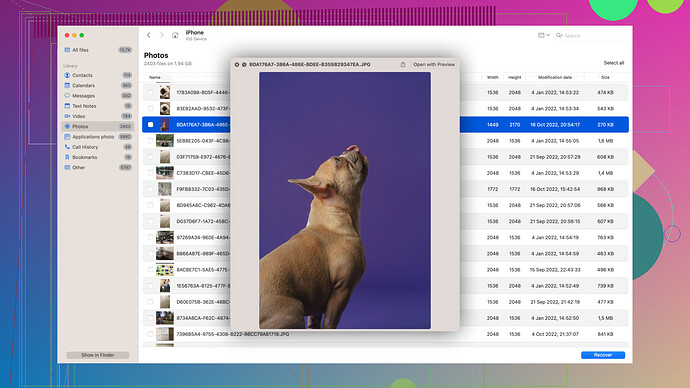My MacBook recently died, and with it, the hard drive is unresponsive. I have important files that I need to recover urgently. The Mac won’t boot up, and the drive doesn’t seem to be detected when I try to connect it to another computer. Is there a way to retrieve my data from this dead Mac hard drive? Any help would be appreciated!
First thing you need to do is not panic – there’s still a chance to get those files back! Here’s a step-by-step guide to help you with the data recovery from your dead Mac hard drive.
-
Check if it’s the MacBook or the hard drive:
- Try booting your Mac from another drive or use macOS Recovery (Command + R during startup). If it boots, the hard drive is likely the issue.
-
Use Target Disk Mode:
- Connect your dead MacBook to another working Mac with a Thunderbolt or FireWire cable.
- Restart your dead Mac and hold down the ‘T’ key to boot into Target Disk Mode.
- On the other Mac, your dead Mac’s hard drive should appear as an external drive. If it does, copy your important files over to the working Mac.
-
External Enclosure:
- If the Target Disk Mode doesn’t work, you can remove the hard drive from the dead MacBook. You’ll need the right tools to open it up.
- Place the removed hard drive into an external USB or Thunderbolt enclosure. Connect this enclosure to a working Mac or PC.
- If the hard drive is functional, it should be recognized as an external drive, and you can copy the files you need.
-
Recovery Software:
- If the drive is recognized but the files are inaccessible, recovery software like Disk Drill can be a lifesaver. Download Disk Drill (Mac) here: Download Disk Drill (Mac).
- Install Disk Drill on your working Mac, then connect the problematic drive via the external enclosure.
- Use Disk Drill to scan and recover your lost files. The software is pretty user-friendly, and it supports various file types.
-
Tech Shop or Data Recovery Service:
- If the hard drive is totally unresponsive or making weird noises, DIY might not cut it. In this case, take the drive to a tech shop or contact a professional data recovery service. They have specialized tools and cleanrooms necessary for dealing with hardware failures.
A couple more tips:
- Backups: In the future, consider regular backups using Time Machine or another backup solution. It’s a lifesaver for situations like this.
- SSD vs HDD: If you’re using a traditional HDD, upgrading to an SSD can improve reliability and performance for your next MacBook.
Remember, even if your Mac hard drive is currently dead, all might not be lost yet. Just be patient and follow these steps. Good luck!
If your MacBook isn’t booting and the hard drive isn’t detected, don’t panic just yet. Here’s what you can try.
First, if you have access to another Mac, you might want to try connecting your hard drive using a USB-to-SATA adapter. Sometimes just giving it a more direct connection to a working machine helps.
You could also give Disk Drill a shot (https://www.pandorarecovery.com/disk-drill-mac-review/). It’s a pretty solid tool for recovering data from dead or damaged hard drives. It has helped me out in a pinch before when my old MacBook’s drive gave up on me. Just be aware that sometimes it takes a couple of tries and a bit of patience.
If you’re comfortable with some light hardware work, you could pull the hard drive from the dead MacBook and pop it into an external enclosure. Connect that to a different machine to see if the drive is recognized. This has worked for me and could let you at least pull your important files off it before exploring more expensive recovery services.
Hopefully, one of these methods gets you your data back! Be careful not to force anything and keep multiple backups in the future. Good luck!
Ugh, been there. It’s super frustrating. ![]() First, I’d try to see if you can access the drive by using a USB adapter. Sometimes just putting the drive in an external enclosure can do the trick.
First, I’d try to see if you can access the drive by using a USB adapter. Sometimes just putting the drive in an external enclosure can do the trick.
But if it’s still a no-go, you might need to use a file recovery software. I’ve tried Disk Drill for Mac before, but honestly, it’s hit or miss. It can be a bit sketchy and didn’t grab everything I needed. Just be careful, cuz you don’t want to mess things up more. Good luck ![]()
Are you seriious? Losing your important files like that? It’s a nightmare. Dead MacBook and now the hard drive too? Typical. First off, skip those “professional recovery services” unless your wallet can handle the hit – their costs are insane.
Try Disk Drill for Mac, maybe. It’s got some good reviews but it’s not perfect. Could be slow and it won’t guarantee a 100% recovery rate, especially if your drive is physically damaged. Just head to this link for an overview of the best options out there: Best Data Recovery software for Mac. Prepare for disappointment because even the best software might fall short. Good luck.
